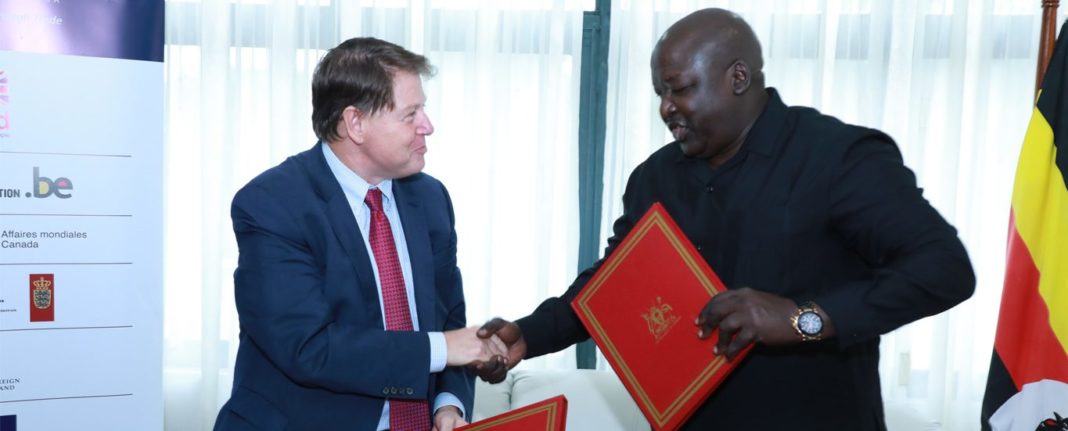Trademark East Africa (TMEA) and the Government of Uganda have signed a Host Country Agreement (HCA) extending the agency’s partnership to the year 2023.
In the agreement, the two have sides committed to support interventions that will lead to creation of at least 100,000 jobs in Uganda, poverty reduction and increase trade for Uganda.
The HCA marks the commencement of TMEA’s US$ 53 million (about Shs196.1 billion) second phase of interventions which will be implemented between 2018-2023. This value expected to reach US$100 million (about Shs370 billion) by 2023.
Uganda’s Minister of State for Foreign Affairs in Charge of International Affairs, Henry Okello Oryem, represented the Government of Uganda. TradeMark East Africa (TMEA) was represented by its CEO, Frank Matsaert.
In its second phase, TMEA commits to work with Government and private partners to support development of Trade Logistics Clusters in Jinja and Busia, construction of the Gulu Logistics Hub, construction of the Goli/ Mahagi One Stop Border Posts (OSBP), decentralization of standards testing and Phase II of the Uganda Electronic Single Window.
It will also extend its work in supporting quality standards in key export sectors like tea, coffee, meat and horticulture, automation of trade processes and work in facilitating trade nationally and beyond Uganda’s borders.
The agency will also support green growth and climate change mitigation and resilience, while creating equal opportunities for all, and endeavouring to incorporate and protect the communities where we work. It will also deepen its support for women in trade with a focus on building capacity of women traders.
The group CEO Matsaert said: TMAE will contribute to creation of additional employment opportunities as investors capitalise in the transport and manufacturing sectors and export growth. Our second phase – will consolidate successes achieved by our partners and innovate around lessons we have learned so far. What we will have is a leaner, more efficient programme that will deliver at least 100,000 jobs for the people of Uganda in 6 years.”
Speaking at the event minister Oryem said, “TradeMark East Africa is one of our valued partners. We commend it for its speed of implementation and willingness to listen to and respond to our priorities. TMEA’s new strategy augers well with government plans of raising Uganda’s profile and increasing our export competitiveness.”
TMEA’s first phase (2010-2017) in Uganda through its US$ 100 (about Shs370 billion) programme supported among others construction and operationalisation of the Four One Stop Border Posts at Busia, Mutukula, Mirama Hills and Elegu; The upgrade of 37Km Ntungamo-Mirama Hills Road from gravel to tarmac.
It also upgraded customs management systems for Uganda Revenue Authority (URA) improving efficiency, reducing time and cost associated with customs processes; Implementation of Uganda Electronic Single Window, facilitating trade by reducing costs and time for import and export processes.
Private Sector support to national logistics platform, improving logistics standards and advocacy; Improved Standards and testing capacity by UNBS, testing time reduced from 19 days to 3 days and NTBs elimination, facilitating reporting and removal of NTBs thought the Ministry of Trade. A recent evaluation of TMEA’s first phase of programming in Uganda indicates a 14% return on investment (ROI) and that the interventions induced US$ 52 million (about Shs192.4 billion) worth of trade.
As a result, there has been a 5.7 per cent reduction in transit time between Kampala and Mombasa, with US$50m worth of new trade recorded in the country between 2015/2016. Reduction on the average time on tested items (19 days – 8 days) – 58 per cent drop with testing cost reducing by 71 % – (from US$350 – US$100) with goods exported to the region taking only 30 days compared to the previous 35 days reflecting a 14 per cent drop;
Customs modernization
Uganda Revenue Authority has recorded an increase in revenue by 48 per cent as of June 2015 with customs processing time reducing significantly by 30 per cent – 120 hours to 84 hours; Electronic Cargo Tracking System.





